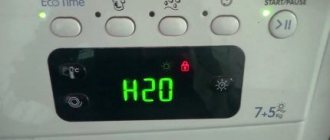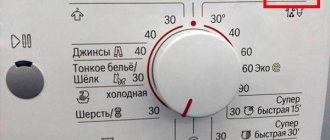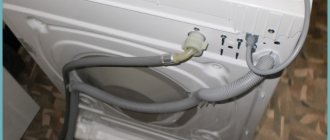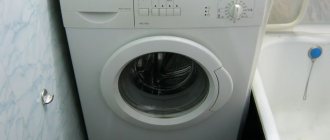Often during operation a problem arises when the washing machine does not heat the water or does not heat it enough. If such a malfunction occurs, most modern models with an automatic self-diagnosis system stop working and display a fault code on the display. Simpler units usually continue the washing process in cold water, which can make it difficult to detect this breakdown in a timely manner.
The first obvious sign of insufficient or complete absence of heating during the washing process is poorly washed laundry. You can check and fix this malfunction yourself or with the assistance of a repairman from the service center.
Fault detection methods
There are several ways to test an automatic washing machine for the functionality of the heating element. The simplest and most informative diagnostic option is carried out in the following sequence:
- Place a small amount of cotton laundry in the drum.
- Select the automatic washing mode, in which the temperature of the liquid inside the machine should be at least 60˚C.
- Press the “Start” button.
- After the household appliance has been operating for about 20 minutes, place your palm on the glass part of the loading hatch.
If you feel warmth when touched, this indicates that the washing machine has heated the water inside the drum.
Some models of washing machines, Bosch and Zanussi have a large number of washing programs. Therefore, if for some reason it was not possible to determine in time the heating of the liquid in the manner described above, and the draining of the liquid has already begun, then it is enough to touch the drain hose to determine the temperature of the water removed from the washing machine.
To finally make sure that the machine is heating water, you should pay attention to the electric meter. The heating element of a washing machine can consume 2 or more kilowatts of electricity per hour, so its inclusion in operation will be indicated by the frequent blinking of the control LED and the movement of numbers in the far right row of the meter.
In order to avoid getting false results during this experiment, it is recommended to turn off all devices that consume electric current, including the refrigerator and lighting elements that use incandescent lamps.
If during the experiments it was possible to determine the performance of the electric heating element, then you can continue to operate the washing machine as usual. Otherwise, you will need to find out why the liquid is not heating.
Part Search
If you have doubts about the performance of the heating element, you will have to “ring” it with a multimeter. First you need to find the device itself in the machine. Its location largely depends on the manufacturer’s brand, for example, in Indesit and Ariston it is located at the back, in models from Bosch and Siemens it is at the front.
Having in hand the factory wiring diagram for the heating element in the washing machine, you can speed up the search.
If there are no instructions, then we look for the heater ourselves:
- We examine the back wall of the machine. Often a large panel indicates a heating element located behind it;
- put the body on its side or tilt it back to look into the bottom and try to detect the heating element near the washing tub;
- remove the back cover and carefully inspect the space around the tank;
- We take a flashlight, shine a light through the inside of the drum and try to determine by eye the location of the heater.
The task is simplified by the fact that the heating element is always in the washing tub. It is only necessary to specify its location. There is no need to remove the device - you can “ring” the heater without removing it. We’ll tell you how exactly later.
The washing machine does not heat the water: reasons
If, as a result of the test, the machine door does not heat up and the meter does not respond to turning on the household appliance, then this “behavior” of the washing machine may be caused by the following malfunctions:
- Incorrect connection of the household appliance.
- Wrong washing program selected.
- The heating element has burned out.
- Thermostat is faulty.
- The control unit is faulty.
If you have just purchased a household appliance and this is the first start-up, then there may be a manufacturing defect or the wires may have come loose during transportation. Such a malfunction can be eliminated by contacting a sales organization to replace or repair the washing machine.
Many washing programs have a limitation on maximum water heating, so choosing such an algorithm for the operation of the device may lead to a false determination that this function is not working. To eliminate this possibility, you should carry out additional testing of the equipment by repeating the procedure, but choosing a different washing program.
The heating element can burn out in almost any washing machine, but such a nuisance especially often happens with Indesit equipment. In addition, frequent washing in hard water without the use of special softening chemicals can also cause damage to the heating element. It is almost impossible to reliably identify a malfunction of the heating element without removing this element from the household appliance, so if you do not have experience in repairing complex household appliances, you should contact a specialized workshop or call a specialist to your home.
A malfunctioning thermostat can also cause the water in the washing machine to not heat up. To check the functionality of this element, you also cannot do without removing it from the body of the household appliance.
The malfunction of the control unit is classified as complex, but you should start diagnosing the software module only after the heating element and thermostat have been checked. In some cases, you can fix the malfunction of this element yourself, but if the control program has failed, then restoring the washing machine’s functionality will be impossible without the involvement of a qualified specialist.
Summing up
If the washing machine does not heat the water during washing and continues to operate, this does not mean that the problem can be postponed until later. Firstly, the quality of washing is significantly reduced. And it cannot be compensated for by adding more powder. Secondly, problems can be with both the control module and the wiring, which makes operating the washing machine simply unsafe. At the same time, the absence of heating may indicate the beginning of more serious problems with the detectors that control the operation of the equipment. Therefore, equipment needs high-quality diagnostics and maintenance, which can only be provided by professionals in a service center.
Tips and tricks
- To determine the heating of water in devices with vertical loading, it is enough to touch the side surface of the device while the device is operating. To detect a breakdown, in this case, you can also record the counter readings before turning on the washing machine and after the end of the washing cycle. The changes must be at least 0.5 kW. The temperature of the drain hose can also be used to determine the presence or absence of heating in household appliances of this type.
- If, as a result of “thermal” tests, it was not possible to detect signs of heating and you decide to independently remove the internal elements for inspection, then you should definitely turn off the power to the washing machine and turn off the water supply.
- In order not to miss the moment when the washing machine heats the liquid, it is recommended to touch the glass part of the door several times during washing. It should also be borne in mind that if the washing process is completed and the rinsing procedure has begun, then, in many cases, the glass and hose of the household appliance will be cold.
- The performance of the heating element can be determined using a multimeter. A working device will show a resistance of several tens of ohms. You can read about how to find out if the heater is working properly in specialized literature, but the simplest test is using a light bulb and a twelve-volt battery. If you pass an electric current through a heating element, the lamp connected to it will light up.
- If the heating element is fully operational, but there is a significant layer of scale on its surface, then to restore the functionality of the device you will need to completely clean the metal of calcium deposits.
How to determine whether a washing machine is heating water or not is no longer a secret. In most cases, the diagnostic methods listed above allow you to accurately determine the performance of the heating element.
Heating element test
First, disconnect the washing machine from the power supply and turn off the water tap. Next, we provide free access to the heater and, if necessary, remove the back wall or bottom. Next, take a multimeter and start testing.
- We photograph the heating element to record the connected wiring and eliminate errors during future installation.
- Disconnect all connected wires.
- We set up the multimeter to measure resistance and set the selector to 200 Ohms.
- We attach the probes to the contacts.
- Let's evaluate the result.
Failure or failure of the pressure switch
Although the pressure switch is responsible for filling the tank with water, it can cause the washing machine not to heat. How to determine whether the pressure switch is faulty without disassembling the washing machine:
To check the pressure switch manually, you can perform the following steps:
It should be noted that the technical documentation of the washing machine, as a rule, does not indicate the electrical circuit of the pressure switch. Therefore, without having a diagram of a specific model, you need to go through all the options for pairs of contacts. In this case, service center workers can carry out both diagnostics and repair of devices much more efficiently and quickly.
Replacing a pressure switch with a new one has certain nuances. Installing a new device yourself and connecting it does not cause any special problems. However, most devices require additional configuration for a specific washing machine model. Depending on the model, the sensor may have up to three screws. They regulate the amount of water required during the washing process for each specific program that the washing machine runs. It is almost impossible to determine the required volume on your own. Therefore, if you are not one hundred percent sure that the pressure switch you purchased is already configured to work for a specific model of washing machine, it is better to entrust its installation and configuration to the technicians from the service center.
Possible locations of the problem
Some machines, especially models with automatic self-diagnosis, if they do not heat the water, then immediately refuse to work. While their more responsible brothers continue to perform their main function - washing clothes, albeit in cold water.
If a machine that does not heat the water still continues to wash, this does not mean that the problem does not need to be solved.
The fact is that such incorrect operation can lead to more serious damage. Incorrect operation of the device may be the result of failure of some parts:
Each of these malfunctions explains why the washing machine cannot heat the water and the laundry does not wash.
Problems with the heating element
The first and most likely reason why the washing machine does not heat the water is the failure of the heater - the heating element. To check the part, it must be removed from the washing machine. This is done as follows:
The heater is located at the rear near the electric motor pulley.
For some models of washing machines, the heating element is located at the front. To access it, you must follow these steps:
This is a rather tedious and complicated procedure. So if you are not confident in your abilities, it is better to take the washing machine to a workshop.
Testing the heating element
After removing the heating element, you can begin to diagnose it; a multimeter is needed to check. The tester can diagnose the following problems: open circuit, breakdown and current leakage. Let's look at diagnostic methods and working with a multimeter tester in more detail:
In order to check it, you need to install a tester at 20 A. Then connect one probe with a clamp to the heating element. The power cord wire is connected to the second terminal. We plug the power cord into the outlet, and connect the remaining probe to the second wire. The tester monitor should show the calculated value.
Why carry out so many checks, and what conclusion can be drawn from their results? First of all, comprehensive testing helps rule out other reasons why the washing machine is not heating. In the first two cases, the heating element must only be replaced. If there is a current leak, repairs are possible, but they can only be carried out in a service center. Although in most cases it is more economically feasible to purchase a new heating element.
Cleaning scale on heating elements
Scale on heating elements is one of the main reasons for reduced washing efficiency, especially in areas with hard carbonate water. In addition to significantly increasing the energy consumption of the washing machine, it can lead to other, more serious problems and breakdowns. Pieces of scale can clog the drain hose, pierce the pipes or tank wall, or jam the drum. Descaling can be done in several ways.
Wrong washing program selected
Sometimes, due to simple inattention, a washing mode may be selected that does not involve heating the water (delicate wash, etc.). Some washing machine models allow you to select the water temperature in the machine and the washing method by turning various switches or knobs. So, for example, even by choosing a washing temperature of 95 degrees, you can accidentally select a mode that provides washing at a temperature of about 40 degrees. Since the washing program has priority over the temperature regime, accordingly, the temperature of the water in the tank will not exceed 40 degrees.
To prevent this situation from happening again, you need to carefully read the instructions for the washing machine and select the washing mode and temperature accordingly.
Heating element test
First, disconnect the washing machine from the power supply and turn off the water tap. Next, we provide free access to the heater and, if necessary, remove the back wall or bottom. Next, take a multimeter and start testing.
- We photograph the heating element to record the connected wiring and eliminate errors during future installation.
- Disconnect all connected wires.
- We set up the multimeter to measure resistance and set the selector to 200 Ohms.
- We attach the probes to the contacts.
- Let's evaluate the result.
A working heater always shows a fixed value of 26.8 ohms. Slight deviations from the norm within +-5 are possible. If one is displayed on the screen, then a line break has occurred inside the heating element and a part change is necessary. When the tester showed “0” or another number less than 1, a short circuit was detected and the element burned out.
Voltage drops in the electrical network and hard water with an abundance of impurities lead to problems with the heater.
Often, checking for resistance is not enough, since if the external condition is good, the dielectric inside can leak into the housing and cause a current leak. To ensure safe operation of the machine, it is recommended to check the heating element for breakdown. It is enough to turn the tester into buzzer mode, attach one probe to the contact, and attach the second to the body of the multimeter. If there is no piercing squeak, everything is fine. Otherwise, it is necessary to urgently change the part and not use the machine until the repair is completed.
Control module failure
Control modules for washing machines can be analog (autonomous), electronic, combined (analog with a programmer). If problems begin with this device, the washing machine not only does not heat the water, but may not perform other functions correctly. Having found no problems with the heating element, temperature sensor or pressure switch, you can begin to remove the control board. Let me make a reservation right away: a full repair of this part at home is practically impossible. However, you can take a number of steps to restore functionality in simple cases.
How to disconnect the control panel was described above. The only addition is that before connecting all the wires, you need to photograph them in order to reconnect correctly. Once you receive the control board, you need to carefully inspect it. If the following damage is present, it needs to be replaced or repaired at a service center:
In principle, if you have a soldering station at home and you are familiar with the technology of soldering circuits, you can replace the burnt-out element with a new one. If burnt-out elements are not visible externally, you can diagnose their breakdown using a multi-tester:
The control unit is one of the most expensive parts in a washing machine. It is recommended to repair it yourself only if you are completely confident in a successful outcome. Otherwise, it is better to trust professionals from service centers.
How quickly does it heat up?
A normally functioning heating element with an average power rating in the new technology allows you to bring the water temperature to 90 degrees in an average of 15 minutes. If the heater is particularly powerful, this happens much faster, in 5-7 minutes. However, the device will consume more electricity.
Some users note that even for a quick wash at 40 degrees, the water heats up too slowly. Why this happens is quite simple to explain. Electric heaters are fragile and susceptible to external influences. Flint sticks to the heating element, burns, and limescale appears. The thicker the layer of deposits, the less heat transfer from the heating part.
Important! A heating element coated with scale works 2 times slower, and over time it stops functioning altogether, and the owner has to change the element.
For correct and uninterrupted operation, certain measures must be taken. Firstly, it is important to use special filtration systems to soften the water. This is both safer and cheaper than special chemical compounds sold in hardware stores. Secondly, many experts recommend periodically cleaning the “insides” of the washing machine with a concentrated solution of citric acid.
You need to be very careful with acidic compounds. When exposed to a heating element overgrown with a centimeter layer of lime, large pieces of hardened plaque fall off, which can get stuck between the drum and the heating element. As a result, the machine will jam, and the heater will crack, break, and the device will stop working.
In order to avoid such problems, it is recommended to remove the heating element before cleaning. It is cleaned of plaque and then installed back. Even after proper cleaning, you need to take preventive measures (use filters, clean the drum with citric acid).











